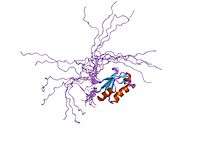Calcipressin
In molecular biology, the calcipressin family of proteins negatively regulate calcineurin by direct binding. They are essential for the survival of T helper type 1 cells. Calcipressin 1 is a phosphoprotein that increases its capacity to inhibit calcineurin when phosphorylated at the conserved FLISPP motif, this phosphorylation also controls the half-life of calcipressin 1 by accelerating its degradation.[1]
| Calcipressin | |||||||||
|---|---|---|---|---|---|---|---|---|---|
 solution structure of rrm domain in calcipressin 1 | |||||||||
| Identifiers | |||||||||
| Symbol | Calcipressin | ||||||||
| Pfam | PF04847 | ||||||||
| Pfam clan | CL0221 | ||||||||
| InterPro | IPR006931 | ||||||||
| |||||||||
In humans, the Calcipressins family of proteins is derived from three genes. Calcipressin 1 is also known as modulatory calcineurin-interacting protein 1 (MCIP1), Adapt78 and Down syndrome critical region 1 (DSCR1). Calcipressin 2 is variously known as MCIP2, ZAKI-4 and DSCR1-like 1. Calcipressin 3 is also called MCIP3 and DSCR1-like 2.[2]
References
- Genesca L, Aubareda A, Fuentes JJ, Estivill X, De La Luna S, Perez-Riba M (September 2003). "Phosphorylation of calcipressin 1 increases its ability to inhibit calcineurin and decreases calcipressin half-life". Biochem. J. 374 (Pt 2): 567–75. doi:10.1042/BJ20030267. PMC 1223619. PMID 12809556.
- Parry RV, June CH (September 2003). "Calcium-independent calcineurin regulation". Nat. Immunol. 4 (9): 821–3. doi:10.1038/ni0903-821. PMID 12942079.